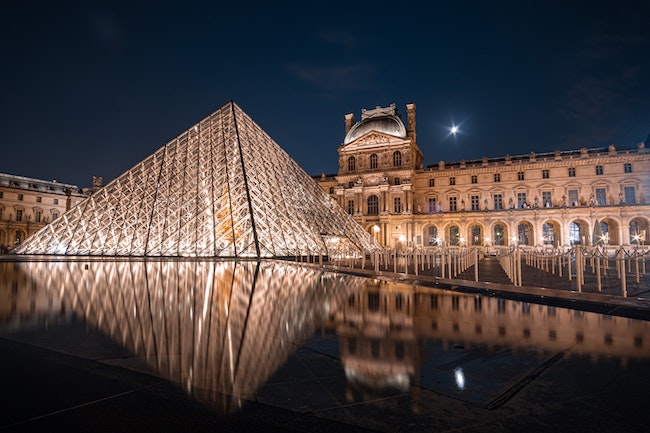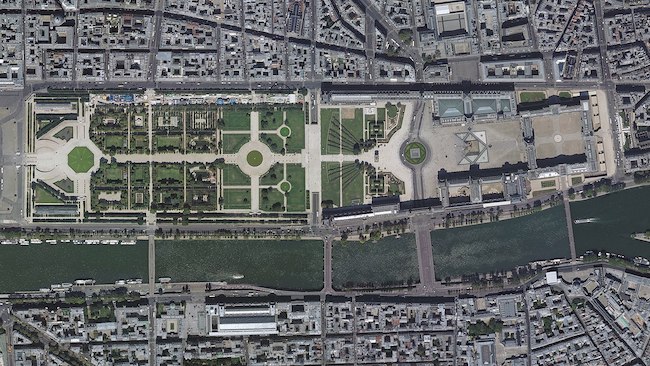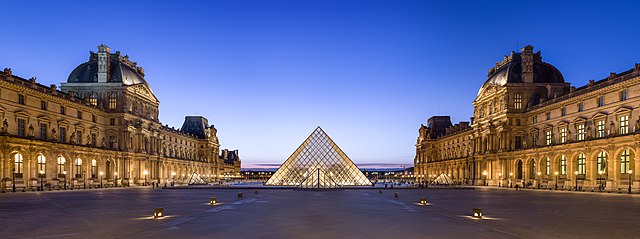The Louvre: Fortress, Palace, Museum


- SUBSCRIBE
- ALREADY SUBSCRIBED?
BECOME A BONJOUR PARIS MEMBER
Gain full access to our collection of over 5,000 articles and bring the City of Light into your life. Just 60 USD per year.
Find out why you should become a member here.
Sign in
Fill in your credentials below.
A lifetime would be nowhere near long enough to appreciate the Louvre’s stunning collections from all over the world. But even if you managed it, you would still have missed something important, namely the building itself and the history it represents. Originally a fortress, then a royal residence and seat of political power and finally a world-renowned art museum, this is a site which contains within its walls much that is also the story of Paris itself.
It all began in the early 1200s, when Philippe Auguste, mindful that the English occupied Normandy and might attack Paris while he was away on a crusade, built a wall to protect the city and then added a fortress, complete with high tower to deter invaders. Its military role diminished in the 14th century when Charles V converted it into a residence and became the first king to live there.

Aerial view of the Louvre Palace and Tuileries Park. (C) Unknown author, Public Domain
François I, who reigned from 1515, liked the site, finding it “most fitting and convenient,” but he wanted a new building, one inspired by his love of Italy and the Renaissance, where he could store his art collection. His plans were so extensive that a visiting Venetian feared the project would never be completed. If it were, he said “one could rightly say that it was one of the world’s most beautiful edifices.” It is thanks to François that the first stones of the building we know today were laid and from then on the palace was to be the home of France’s reigning monarch and a seat of royal power.
Henri II continued the work after the death of his father, François. He added the Salle des Cariatides, a large room named after the four sculpted female figures built as columns to support a musicians’ gallery up above. The room, now home to a collection of Greek sculptures, was originally used as the royal ballroom. Typically renaissance in style, it was modeled on the Forum of Augustus in Rome. But Henri, certainly an art lover, was also capable of acts of cruelty. One room, known as the chambre ardente (“fiery chamber”) was used as a courtroom, where some 500 religious dissenters were tried, 40 of whom were sentenced to death by burning for such “crimes” as reading the bible in French, not Latin, or eating meat on Fridays.

Portrait of King Henry II of France. (C) François Clouet, Public Domain
In the 1570s, Henri, the Huguenot King of Navarre, was only 19 when he came to Paris to marry Margaret of Valois, a French catholic princess, but his stay at the Louvre, along with many other protestant guests, proved disastrous. The building was attacked by a catholic mob who objected to the marriage on religious grounds and although Henri managed to escape alive, the violence, later known as the St Bartholomew’s Day Massacre, escalated to the point where some 2000 people were killed. Later, as Henri IV, he supervised major construction work, most notably the building of a huge riverside gallery connecting the Louvre to the nearby Tuileries Palace, which was the longest building of its kind in Europe.

St. Bartholomew’s Day massacre. (C) François Dubois, Public Domain
In the reign of Louis XIV the use of the building as a gallery evolved. In the 1660s he employed an architect to design the Galérie d’Apollon, named after the Greek god of the sun, and the room was sumptuously decorated in gold and fine paintings. It soon became the place for members of the Royal Academy of Painting and Sculpture to display their works. When, later in his reign, Louis tired of being under close scrutiny in Paris and moved his court to Versailles, the Louvre fell into disrepair until 1699 when it was taken over by the Academy, who wished to hold salons there. So, gradually, the building’s connection with painting and sculpture was strengthened.
From the 1740s there was talk of opening the gallery to the public. Louis XVI proposed renovations and renaming the building as Le Musée Français, but it was not until after the revolution that this actually happened. On August 10th, 1793, the first public exhibition opened, showing 573 paintings, most of them confiscated royal and church property. Then followed the museum’s greatest expansion phase because Napoleon began sending artistic trophies from lands he had conquered to the newly renamed Musée Napoléon. A new wing had to be built to accommodate all these spoils which were paraded around Paris in triumph and then added to the collection. Some were returned after Napoleon’s defeat, but the vast majority were not.

The display in the Salon Carré. (C) Giuseppe Castiglione, Public Domain
The turbulent history of France in the 19th century was reflected in the story of the Louvre. Anti-royalist pillage meant works were lost in 1830, but sumptuous new state apartments were added in the Second Empire when gold, velvet, and stucco decorations provided the backdrop for prestigious dinners and masked balls. The Salle d’État was built in the 1850s so that Napoléon III could preside over legislative sessions in splendor and pomp. In 1871, during the suppression of the Commune, the museum only narrowly avoided the fate of the Tuileries Palace next door which was burned to destruction. Although the fire, which lasted for 48 hours, did spread to some parts of the Louvre it was saved by the heroic efforts of firemen and museum employees.

Below-ground portions of the medieval Louvre. (C) Pierre-Emmanuel Malissin et Frédéric Valdesm, CC BY-SA 3.0
During World War II many works were hidden away in the Château de Chambord in the Loire Valley, avoiding disaster once again. President Mitterrand made the Louvre one of his grands projets in 1981, creating much more display room by moving government offices away from the complex and engaging the architect IM Pei to design the new and somewhat controversial Pyramide entrance. For some it was a satisfying blend of the classical and the ultra-modern, the reflective surfaces accentuating the beauty of the surrounding historic buildings. Others bemoaned the “Disneyfication” of a much-loved piece of history. New developments continue this century, with the opening of satellite Louvres in the former coal-mining town of Lens in northern France and in Abu Dhabi.
So, the Louvre has been a central feature in Paris for over 800 years and it is surely irreplaceable. No wonder that when another president, Georges Pompidou, wanted art at the centre of his grand projet it was on modern art that he focused. His explanation? “We already have the Louvre.” It simply could not be bettered.

The Napoleon Courtyard and Ieoh Ming Pei’s pyramid in its center, at dusk. (C) Benh LIEU SONG, Flickr
Lead photo credit : The Louvre at night (C) Michael Fousert, Unsplash
More in 1st arrondissement, Art, Battle, Henri II, Museum, Paris, World War II




REPLY
REPLY